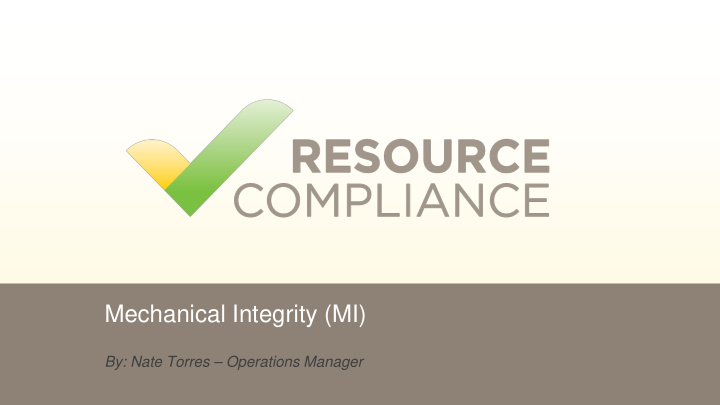



Providing Solutions. Simplifying Regulation. Mechanical Integrity (MI) By: Nate Torres – Operations Manager
Providing Solutions. Simplifying Regulation. Outline • What is Mechanical Integrity? • Purpose of Mechanical Integrity? • Scope and regulatory requirements of a Mechanical Integrity Program • Keys to effective Mechanical Integrity Program
Providing Solutions. Simplifying Regulation. What is Mechanical Integrity? An organized plan for performing the following activities on a covered process: 1. Inspections (Visual) 2. Testing (Vibration Analysis/Safety Devices/Oil Sampling) 3. Maintenance (Draining Oil/Exercising Valves)
Providing Solutions. Simplifying Regulation. Value (purpose) 1. Prevent failure of process 2. Minimize process down time 3. Prevent accidental releases of process chemical 4. Maximize efficiency of process operation 5. Maximize life of process
Providing Solutions. Simplifying Regulation. Regulatory Requirement Program 2 Prevention Program Section 2755.5 Maintenance: The owner or operator shall perform or cause to be performed inspections and tests on process equipment. Inspection and testing procedures shall follow recognized and generally accepted good engineering practices . The frequency of inspections and tests of process equipment shall be consistent with applicable manufacturers' recommendations, industry standards or codes , good engineering practices, and prior operating experience.
Providing Solutions. Simplifying Regulation. Regulatory Requirement Program 3 Prevention Program Section 2760.5 Mechanical Integrity: (2) Inspection and testing procedures shall follow recognized and generally accepted good engineering practices . (3) The frequency of inspections and tests of process equipment shall be consistent with applicable manufacturers' recommendations and good engineering practices , and more frequently if determined to be necessary by prior operating experience.
Providing Solutions. Simplifying Regulation. Basis RAGAGEP 1. Industry Standards Bulletins and Standards 2. Manufacturer’s Recommendation IOM Manuals 3. Prior Operating Experience Historical Operating Data
Providing Solutions. Simplifying Regulation. Industry Standards CGA G-3 2017 Sulfur Dioxide • Wineries • Cold Storage Fumigation • Dehydrators CGA G-2.1 2014 Storage of Ammonia • Agriculture Application • Water Treatment The Chlorine Institute – The Chlorine Manual “information relating to the properties, transportation, storage, and handling of compressed gases”
Providing Solutions. Simplifying Regulation. Industry Standards (Refrigeration) Currently being used as Industry Standard • IIAR Bulletin 109 & 110 • “Guidelines”
Providing Solutions. Simplifying Regulation. Industry Standards Coming Soon : Industry Standards • IIAR 6 - Inspection, Testing, and Maintenance of Safe Closed-Circuit Ammonia Refrigeration Systems “ minimum criteria for inspection, testing, and maintenance of closed-circuit ammonia mechanical refrigeration systems”
Providing Solutions. Simplifying Regulation. Application • Pressure Vessels • Heat Exchangers • Piping and Valves • Compressors • Relief System • Emergency Shut Down System • Pumps * Any component of the process or associated with the process that can cause process failures or accidental releases.
Providing Solutions. Simplifying Regulation. MI Program Elements 1. Schedule of all process equipment 2. Frequency of inspections, tests, and maintenance 3. Procedure to perform each task 4. Form to document task results and identify deficiencies 5. System to ensure deficiencies tracked to completion
Providing Solutions. Simplifying Regulation. Example: Evaporative Condenser 1. Visual Inspections Weekly, Monthly, Annual, and 5-yr 2. Testing Weekly Water Treatment Testing 3. Maintenance Lubricate Fan Bearings Quarterly Annual Cleaning of Water Sump and Strainers
Providing Solutions. Simplifying Regulation. Example: Evaporative Condenser Evaporative Condenser Frequency Operating Procedure Form Weekly Inspection SOP-101 EC-W Monthly Inspection SOP-101 EC-M Visual Inspections Annual Inspection SOP-101 EC-A 5-year Inspection SOP-101 EC-5yr Weekly Water SOP-102 EC-WTT Testing Treatment Test Quarterly Fan Bearings SOP-103 EC-QFB Service Maintenance Annual Sump Cleaning SOP-103 EC-ASC
Providing Solutions. Simplifying Regulation. Example: Evaporative Condenser Visual Inspections of Evaporative Condensers
Providing Solutions. Simplifying Regulation. Example: Evaporative Condenser Visual Inspections of Evaporative Condensers
Providing Solutions. Simplifying Regulation. Example: Evaporative Condenser Evaporative Condenser Frequency Operating Procedure Form Weekly Inspection SOP-101 EC-W Monthly Inspection SOP-101 EC-M Visual Inspections Annual Inspection SOP-101 EC-A 5-year Inspection SOP-101 EC-5yr Weekly Water SOP-102 EC-WTT Testing Treatment Test Quarterly Fan Bearings SOP-103 EC-QFB Service Maintenance Annual Sump Cleaning SOP-103 EC-ASC
Providing Solutions. Simplifying Regulation. Example: Evaporative Condenser
Providing Solutions. Simplifying Regulation. Example: Evaporative Condenser Evaporative Condenser Frequency Operating Procedure Form Weekly Inspection SOP-101 EC-W Monthly Inspection SOP-101 EC-M Visual Inspections Annual Inspection SOP-101 EC-A 5-year Inspection SOP-101 EC-5yr Weekly Water SOP-102 EC-WTT Testing Treatment Test Quarterly Fan Bearings SOP-103 EC-QFB Service Maintenance Annual Sump Cleaning SOP-103 EC-ASC
Providing Solutions. Simplifying Regulation. Example: Evaporative Condenser
Providing Solutions. Simplifying Regulation. Keys to an Effective MI Program 1. Access to equipment 2. Organized Program and Recordkeeping 3. Adequate Budget 4. Sufficient Manpower 5. Trained and Qualified Technicians
Providing Solutions. Simplifying Regulation.
Providing Solutions. Simplifying Regulation. Keys to an Effective MI Program 1. Access to equipment 2. Organized Program and Recordkeeping 3. Adequate Budget 4. Sufficient Manpower 5. Trained and Qualified Technicians
Recommend
More recommend